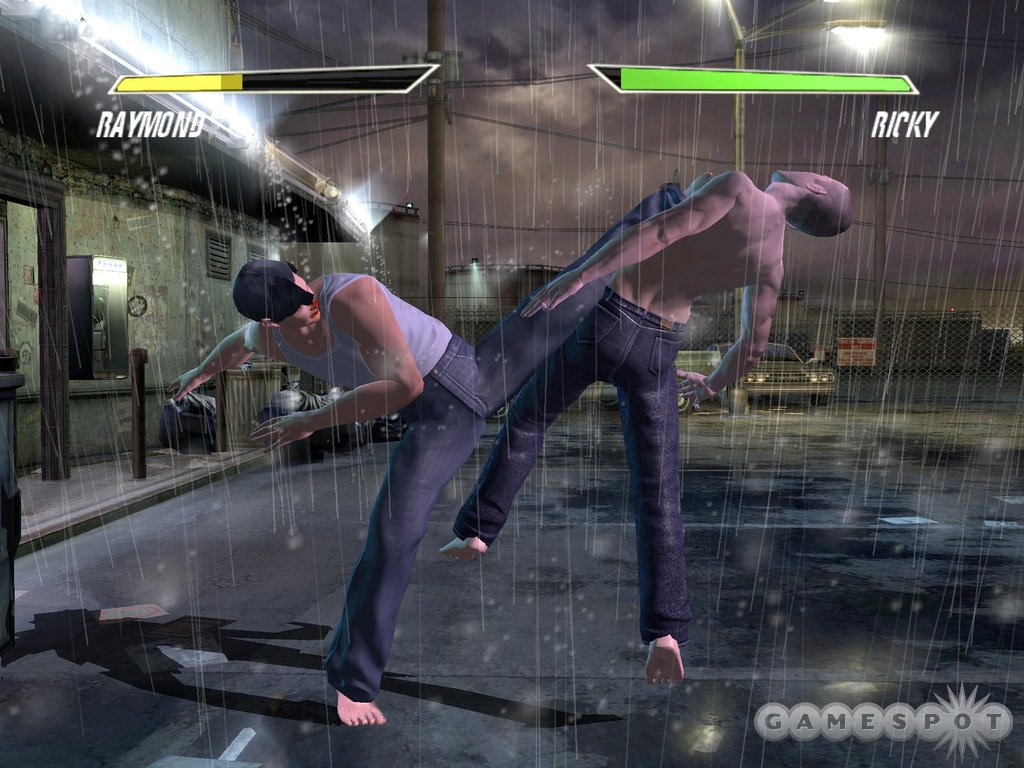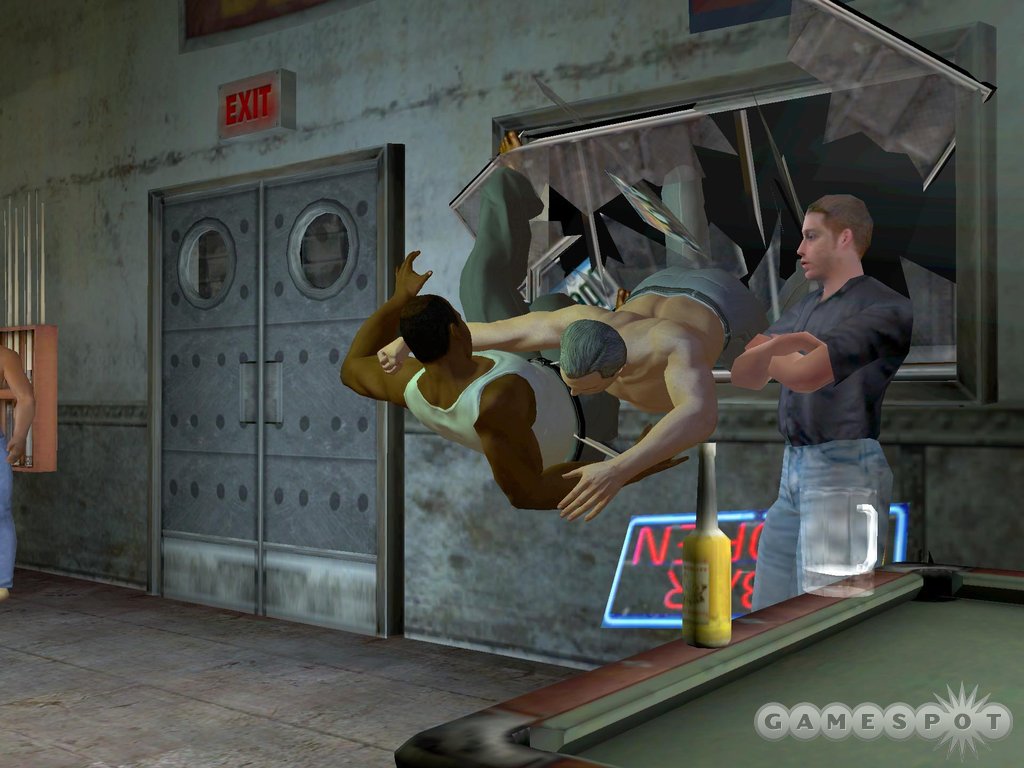Fight Club Hands-On
We go a few bloody rounds in the basement of the ratty old house on Paper Street. New info on game modes inside.
Movie games are bigger business than ever. Any major action film worth its salt these days has an attendant game attached (some of which are actually quite good), and lately older films like Scarface and Jaws are being blessed with the digital treatment too. Furthering this trend, Vivendi Universal and Genuine Games have plucked Fight Club from the recent annals of film history and are crafting--surprise--a fighting game based on the tale of urban psychosis and destruction.
Though we've gotten some information on the core fighting mechanics in Fight Club, we haven't learned much about the modes being included in the game until now. The main single-player component of Fight Club will be its story mode, in which you take control of a hero character that you can customize and name. You'll proceed through a linear sequence of fights against all of the major characters from the movie, and the storyline will more or less be the same one you've seen in the film--but you'll experience it from the perspective of your own character, who starts off on the sidelines and becomes increasingly involved in Fight Club and, later, Project Mayhem. Without spoiling too much for those who haven't seen the movie, senior producer Chris Miller told us that by the end you'd experience the story's explosive climax from a new and unique angle.
Though you can jump into the story mode with a generic character called simply "Hero," you'll probably want to customize your appearance just a bit. Customization options will run the standard gamut from body type and size to hair color, skin tone, clothing choice, and tattoo placement. The character tweaking isn't just superficial, however--as you play, you'll be able to accumulate upgrade points that you'll then use to improve specific aspects of your character's performance. This upgrade system will come in especially handy when you take your custom character online to compete against other humans. Interestingly enough, you'll even be able to lay down a bet before a match, putting your upgrade points on the line for the chance to win big (or lose them all, if you suck).
We played quite a few matches on both the Xbox and PS2 versions of the game and found the fighting system to be pretty accessible after just a short time. The controls are set up similarly to those in Tekken--you've got four attack buttons, one for each limb, and a block button. Attacks can hit high, middle, or low, and there's a basic counter system in place to let you dodge and return attacks without taking any damage yourself. To counter, you'll have to tap block and the direction corresponding to the attack--up, forward, or down--at precisely the right moment. The timing takes a little while to get down, but once you've got it, the counter system will play an essential part in winning fights.

Don't expect any fireballs or hurricane kicks in Fight Club, since you'll be using strictly realistic street-fighting attacks. Well, some of the characters will, at least, since there are three fighting styles in the game: brawler, grappler, and martial artist. Brawlers are the middle-of-the-road street fighters, with lots of medium punch moves; martial artists are quicker, naturally, with more kicks as well as punches at their disposal; and grapplers are slower-moving and deal out a lot of damage with throws and the like. There will be 10 characters available initially, all taken from the film, such as Jack and Tyler (of course), Ricky, Irvin, Bob, Lou, and even Raymond K. Hessel. As for the hidden characters...we'll leave those for you to find out. Just think back to Jack and Tyler's "if you could fight anybody..." conversations, and you'll be on the right track.
The fighting engine features one particularly gruesome bone-breaking mechanic that kicks in at the end of a match. When a character's health is almost gone, you'll see a little yellow warning sign flash at the top of the screen that lets you know the bones are ripe for snapping. After the warning goes off, you simply have to execute a throw move to grab your opponent and break his arm, ribs, or leg in grisly fashion. A quick cinematic replay will show the move in slow motion, giving a quick X-ray view of the unlucky soul's skeleton as the limb bends in an unnatural fashion. A broken leg will take you out of the match immediately, but a broken arm will simply be useless for the rest of the fight, and broken ribs will slow you down substantially. Of course, you can always tap out at any time if you can't stand the injuries and want to forfeit.
Fight Club looks graphically noteworthy at this late stage in development, especially on the Xbox. Both games feature characters with a high polygon count, and the detail is further improved on the Xbox with the normal mapping technique that has most famously been used in Doom 3. Even up close, the surface detail on the characters in the Xbox version is truly impressive. The PS2 characters are a little plainer, but they also look good. Many of the lesser characters from the film, such as Ricky, Irvin, and Lou, retain their facial likenesses, and Meatloaf's Bob even retains his other unseemly assets (complete with physics modeling--ugh). Fight Club also features a pretty realistic visible damage system, so the more you get slugged, slammed, and generally abused, the bloodier and more bruised your character will look. Especially tough hits will even splatter blood onto the camera, which then slowly runs down the screen as you continue to batter your foe.
Just about every notable location from Fight Club will serve as a background in the game, from the waterlogged basement of the condemned Paper Street house to the basement and parking lot where Fight Club was born. You'll even fight in such unlikely places as an airport tarmac or the bathroom where Tyler nearly performed a rather unpleasant operation in the film. Some of these backgrounds will even feature midfight transitions to new areas. For instance, as we fought in the yard outside the house on Paper Street, we were knocked through a window directly into the flooded basement, where the fight resumed.

Genuine seems to be paying due attention to Fight Club's audio as well, since the hits sound about as brutal as you'd expect. There's a bit of celebrity voice talent here, too--Meatloaf provides the voice for his character Bob, for instance. And the movie will be well represented on the game's soundtrack, since the Dust Brothers' exceptional score forms the basis of the included music. An assortment of licensed tracks will round out the background music as well.
Though you might have been skeptical when a game based on Fight Club was first announced--we were, we'll admit--it looks like Genuine has crafted a solid and functional fighter that has got a lot of hooks for big fans of the movie. The roster is well packed with movie characters and some interesting hidden characters, including, strangely enough, Limp Bizkit front man Fred Durst. That fact alone may be enough to pique many gamers' interest in Fight Club, which is scheduled to ship in October. Look for more soon, and for now, please check out our
Got a news tip or want to contact us directly? Email news@gamespot.com
Join the conversation